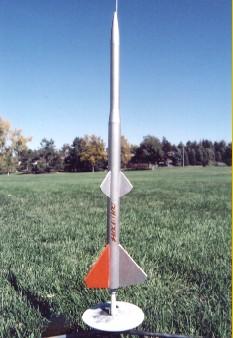Thrustline Aerospace Zack Attack
Thrustline Aerospace - Zack Attack {Kit}
Contributed by Matthew Bond
| Construction Rating: | starstarstar_borderstar_borderstar_border |
| Flight Rating: | starstarstarstarstar_border |
| Overall Rating: | starstarstarstar_borderstar_border |
| Manufacturer: | Thrustline Aerospace |
Brief:
This is a medium priced skill level 2-3 rocket with a payload section as
designed by Thrustline Aerospace.
Construction:
Parts included with this kit were a balsa nose cone and transition piece, a
body tube plus a smaller upper payload tube, engine tube, engine hook,
centering rings and block ring, launch lug, balsa fin stock (not pre-cut), a
screw eye and parachute kit, Kevlar®
thread and elastic shock cord for recovery.
Seven sheets of instructions plus a fin template sheet come with this kit and include photo illustrations. The instructions were useful but the photos were dark and less helpful than illustrations would have been. First up was construction of the motor mount. The centering rings were too snug for the tube, but rather than sanding, I just removed the outer layer of cardboard from the rings which were delaminating anyway. A gap cut in the centering ring allows the engine hook to spring. This gap weakens the integrity of the ring however, and speeds the delamination of the cardboard. The engine hook is then taped to the mount to hold it in place. An engine block ring is also included, but it seems a little like overkill. The Kevlar® cord wraps around the motor mount and threads up through the tube for the recovery system. After inserting the motor mount into the body tube, I found that the hook would not spring far enough to allow engine insertion and removal, so I had to cut a slot out of the body tube to allow for this. Also, the end of the hook was sharp enough to cut your finger and I opted to use a file to smooth it. The fins are not laser cut and you must trace them out on the balsa stock and cut them yourself. A fin positioning guide is included, but I used the Estes Marking Guide instead. The six fins (three lower and three upper) were not hard to align and I used pin holes through the tube (glue rivets) to secure them better. The body tube was somewhat soft with the interior spirals showing through as bumps. I had not seen this ever occur before. The instructions direct you to draw a line for the launch lugs, but then direct you to glue them to the side of the fins. The nose cone and transition did not fit inside the body tube and required a bit of sanding. The mylar parachute was unmade, and no instructions were included for its construction. I substituted a 12" nylon parachute from Thrustline for the mylar one included (Thrustline makes wonderful ripstop nylon chutes). I would rate this kit a 2 on construction and finishing due to the poor fitting parts and their quality. It's about as close to scratch building a rocket as you'll ever get with a kit.
Finishing:
The quality of the balsa was poor and I should have spent more time filling it.
I used about three coats of sanding sealer with little effect. Paste filler
would have worked better. The nose cone wood was so weak, I actually broke the
tip of it off while finishing the rocket, but it glued back on nicely and with
a little filler, wasn't noticeable. After initial painting with chrome spray
paint, I painted one fin with fluorescent orange, then sprayed everything with
multi-colored glitter. After several coats of clear coat to cover the rough
glitter, I attached the single sticker for identification and clear coated the
whole thing again. Even with all the problems I encountered with this kit, the
unique design of the Zack Attack was a welcome addition to the fleet.
Construction Rating: 2 out of 5
Flight:
For the first flight, I used an Estes B6-4 engine. Flight preparation was
typical of simple rockets using wadding. It flew very straight off the pad to
an estimated height of 700 feet and landed about 200 feet from the pad using a
12" nylon parachute in 1-5 mph wind. Some damage occurred to the end of
the body tube from recoil of the payload section. For its second flight, I used
an Estes C6-5. Again, it flew very straight off the pad and reached an
impressive height of about 900 feet, but landed 500 feet from the pad in 1-5
mph wind and again suffered body tube damage from the recoil. If I get 5 more
launches with this rocket, I will be surprised.
Recovery:
Shock cord is attached to Kevlar®
thread running through the body tube from the engine mount. Assembly of the
recovery system was similar to that of Quest rockets. A 12" parachute
seems about right for this rocket, there has been no damage from landing. The
damage is occurring during the ejection phase.
Flight Rating: 4 out of 5
Summary:
The main PROS of this rocket are the way it looks and the way it flies. The
many CONS include substandard quality of materials and recurring damage during
the ejection phase. I will give Thrustline Aerospace another try, and I
recommend that anyone else who likes a challenge do the same.
Overall Rating: 3 out of 5
Other Reviews
- Thrustline Aerospace Zack Attack By Matthew Bond (August 5, 2009)
Brief: Having recently re-energized my addiction to rocketry, I was faced with the task of recreating the core of my previous rocket fleet. Thinking back, I realized that a great many of the rockets that I liked to fly were the designs of John Rowan-Stern at Thrustline Aerospace. Unfortunately, Thrustline was no longer in business this time around (a situation that has since ...
 |
 |
Flights
 |
 |